Project: Machine Learning Application in Human-Computer Interaction
VerifiedAdded on 2022/11/24
|15
|4618
|254
Project
AI Summary
This project delves into the application of Fitts' Law in conjunction with machine learning to analyze and predict human-computer interaction (HCI). Fitts' Law is utilized to estimate the time required for a user to move between targets on a computer screen, considering factors like target size and distance. Machine learning techniques are integrated to build predictive models that learn from user interactions, enhancing the accuracy of time and speed predictions. The project assesses the accuracy of these predictions by measuring user performance, such as the time taken to hit targets, and explores how factors like screen size and target arrangement impact interaction efficiency. The ultimate goal is to optimize user interface designs based on these insights, improving the overall user experience. The project also addresses the limitations of Fitts' Law and how machine learning can compensate for these shortcomings by adapting to various user behaviors and device performance characteristics.
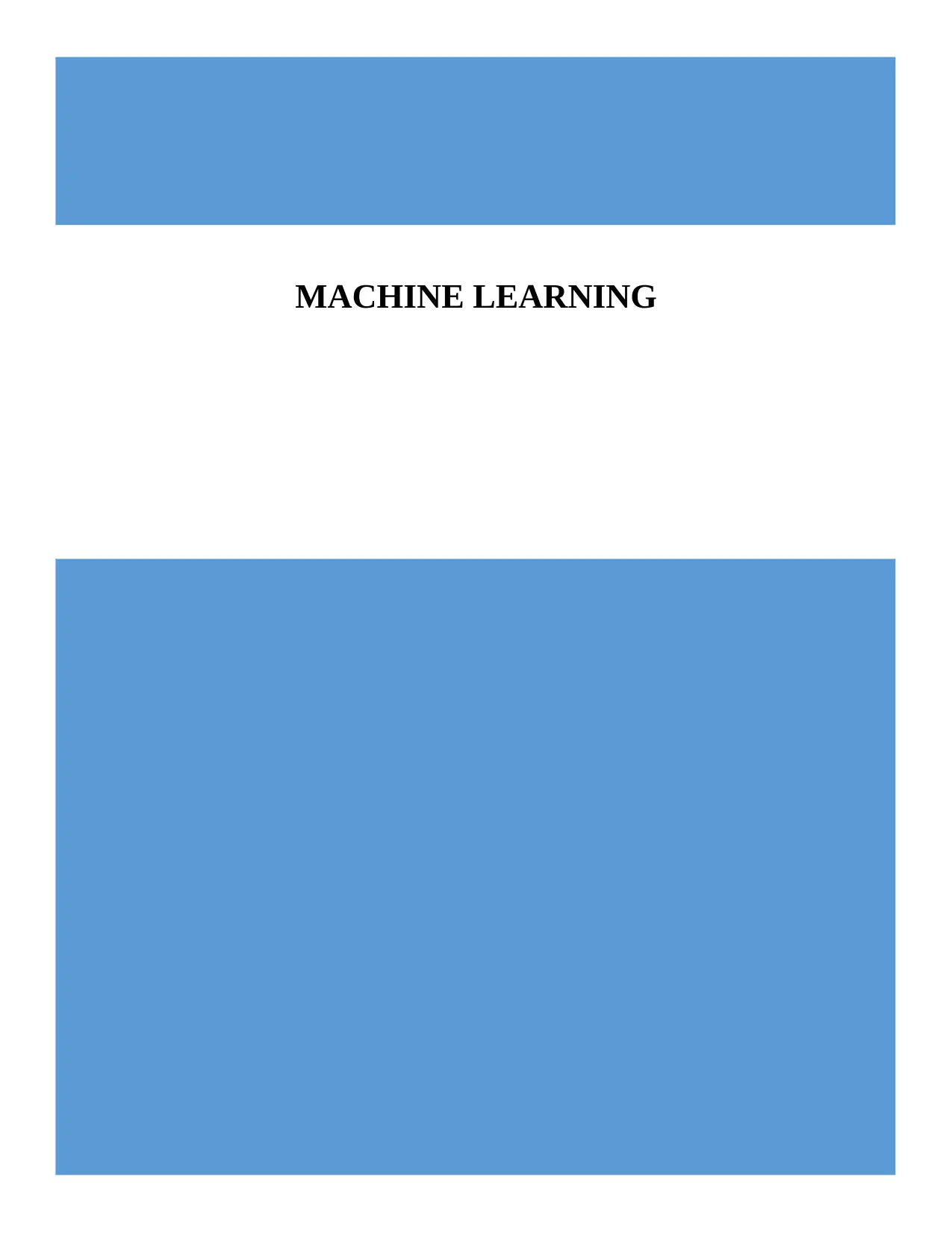
MACHINE LEARNING
Paraphrase This Document
Need a fresh take? Get an instant paraphrase of this document with our AI Paraphraser
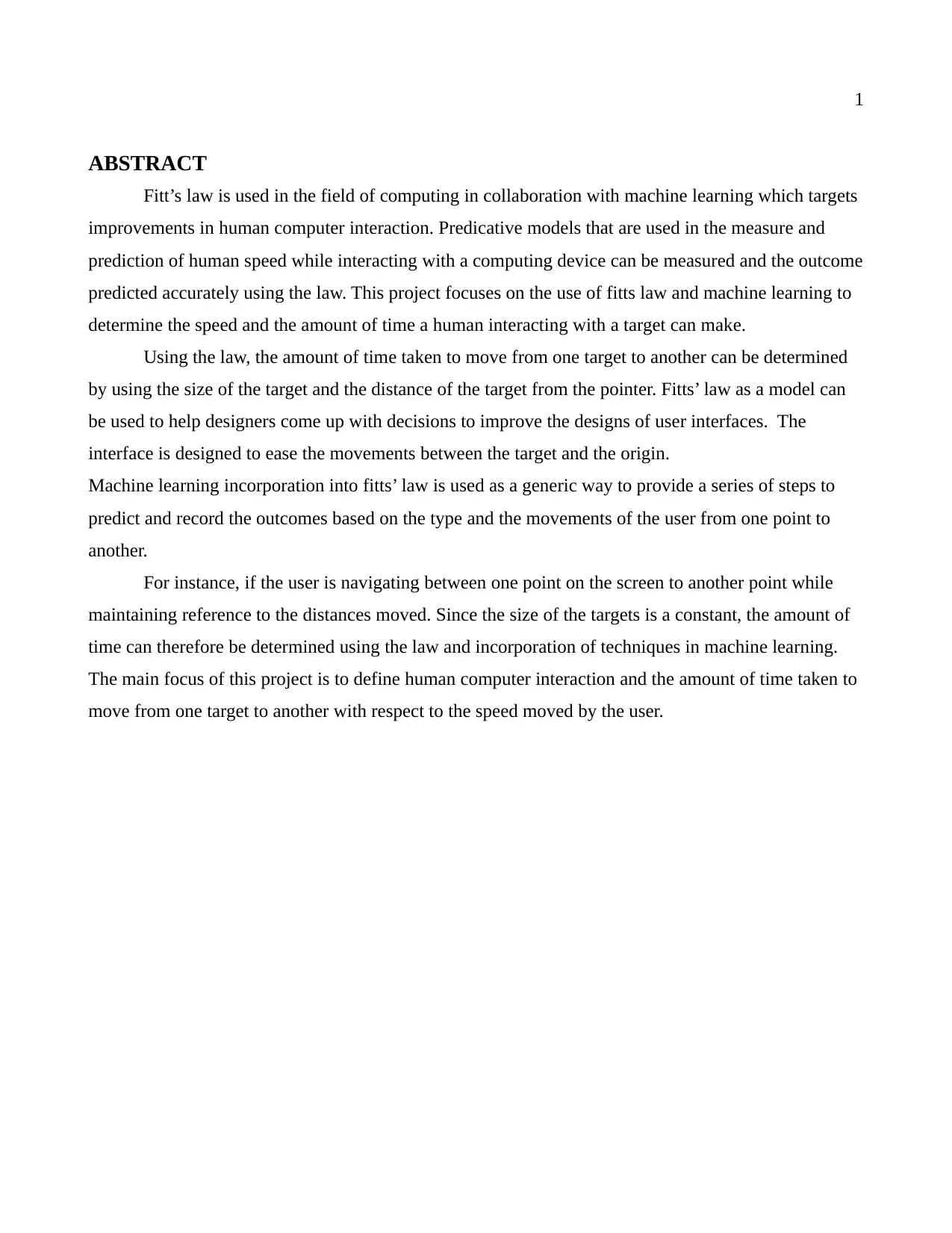
1
ABSTRACT
Fitt’s law is used in the field of computing in collaboration with machine learning which targets
improvements in human computer interaction. Predicative models that are used in the measure and
prediction of human speed while interacting with a computing device can be measured and the outcome
predicted accurately using the law. This project focuses on the use of fitts law and machine learning to
determine the speed and the amount of time a human interacting with a target can make.
Using the law, the amount of time taken to move from one target to another can be determined
by using the size of the target and the distance of the target from the pointer. Fitts’ law as a model can
be used to help designers come up with decisions to improve the designs of user interfaces. The
interface is designed to ease the movements between the target and the origin.
Machine learning incorporation into fitts’ law is used as a generic way to provide a series of steps to
predict and record the outcomes based on the type and the movements of the user from one point to
another.
For instance, if the user is navigating between one point on the screen to another point while
maintaining reference to the distances moved. Since the size of the targets is a constant, the amount of
time can therefore be determined using the law and incorporation of techniques in machine learning.
The main focus of this project is to define human computer interaction and the amount of time taken to
move from one target to another with respect to the speed moved by the user.
ABSTRACT
Fitt’s law is used in the field of computing in collaboration with machine learning which targets
improvements in human computer interaction. Predicative models that are used in the measure and
prediction of human speed while interacting with a computing device can be measured and the outcome
predicted accurately using the law. This project focuses on the use of fitts law and machine learning to
determine the speed and the amount of time a human interacting with a target can make.
Using the law, the amount of time taken to move from one target to another can be determined
by using the size of the target and the distance of the target from the pointer. Fitts’ law as a model can
be used to help designers come up with decisions to improve the designs of user interfaces. The
interface is designed to ease the movements between the target and the origin.
Machine learning incorporation into fitts’ law is used as a generic way to provide a series of steps to
predict and record the outcomes based on the type and the movements of the user from one point to
another.
For instance, if the user is navigating between one point on the screen to another point while
maintaining reference to the distances moved. Since the size of the targets is a constant, the amount of
time can therefore be determined using the law and incorporation of techniques in machine learning.
The main focus of this project is to define human computer interaction and the amount of time taken to
move from one target to another with respect to the speed moved by the user.
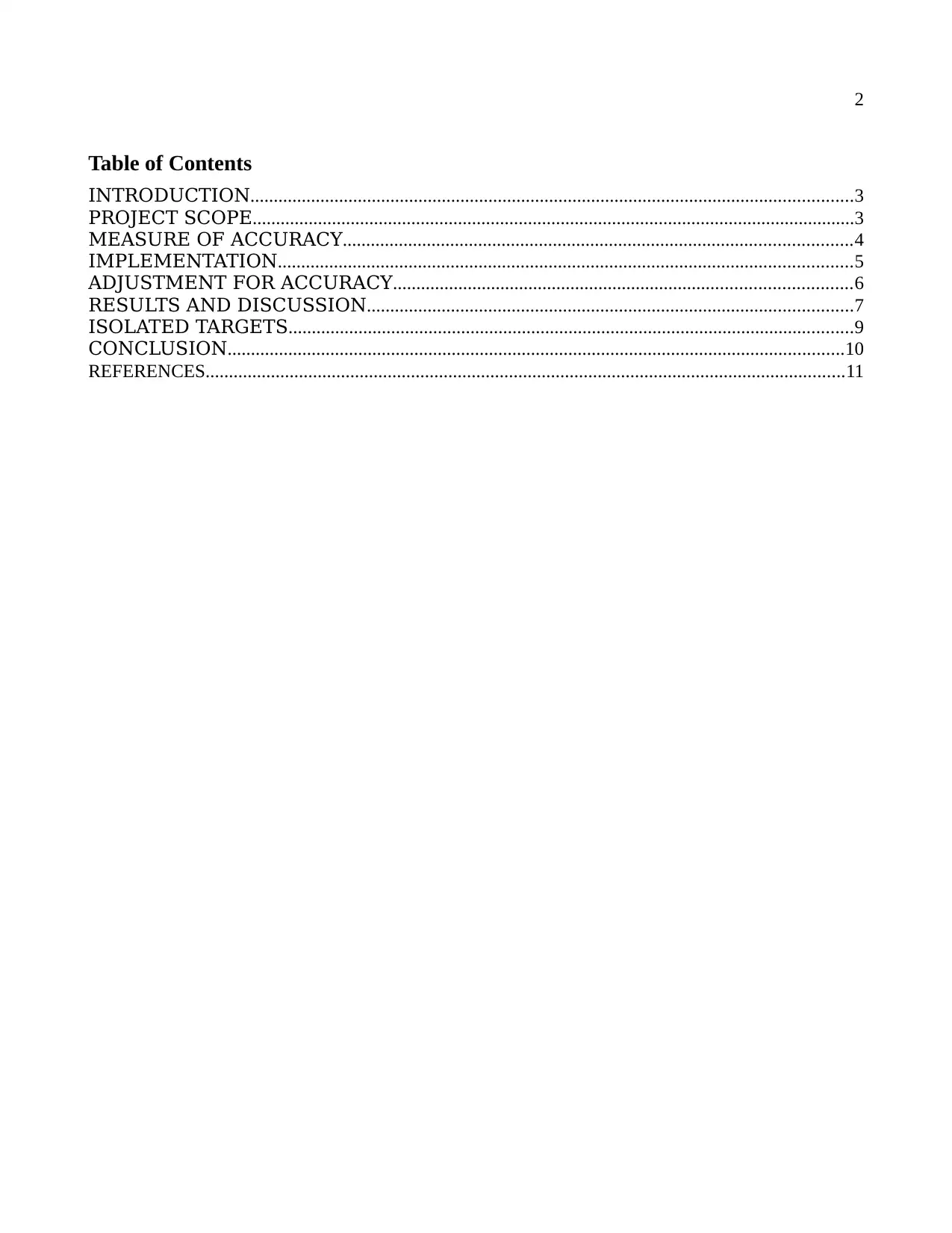
2
Table of Contents
INTRODUCTION.................................................................................................................................3
PROJECT SCOPE.................................................................................................................................3
MEASURE OF ACCURACY.............................................................................................................4
IMPLEMENTATION...........................................................................................................................5
ADJUSTMENT FOR ACCURACY..................................................................................................6
RESULTS AND DISCUSSION........................................................................................................7
ISOLATED TARGETS.........................................................................................................................9
CONCLUSION....................................................................................................................................10
REFERENCES.........................................................................................................................................11
Table of Contents
INTRODUCTION.................................................................................................................................3
PROJECT SCOPE.................................................................................................................................3
MEASURE OF ACCURACY.............................................................................................................4
IMPLEMENTATION...........................................................................................................................5
ADJUSTMENT FOR ACCURACY..................................................................................................6
RESULTS AND DISCUSSION........................................................................................................7
ISOLATED TARGETS.........................................................................................................................9
CONCLUSION....................................................................................................................................10
REFERENCES.........................................................................................................................................11
⊘ This is a preview!⊘
Do you want full access?
Subscribe today to unlock all pages.

Trusted by 1+ million students worldwide
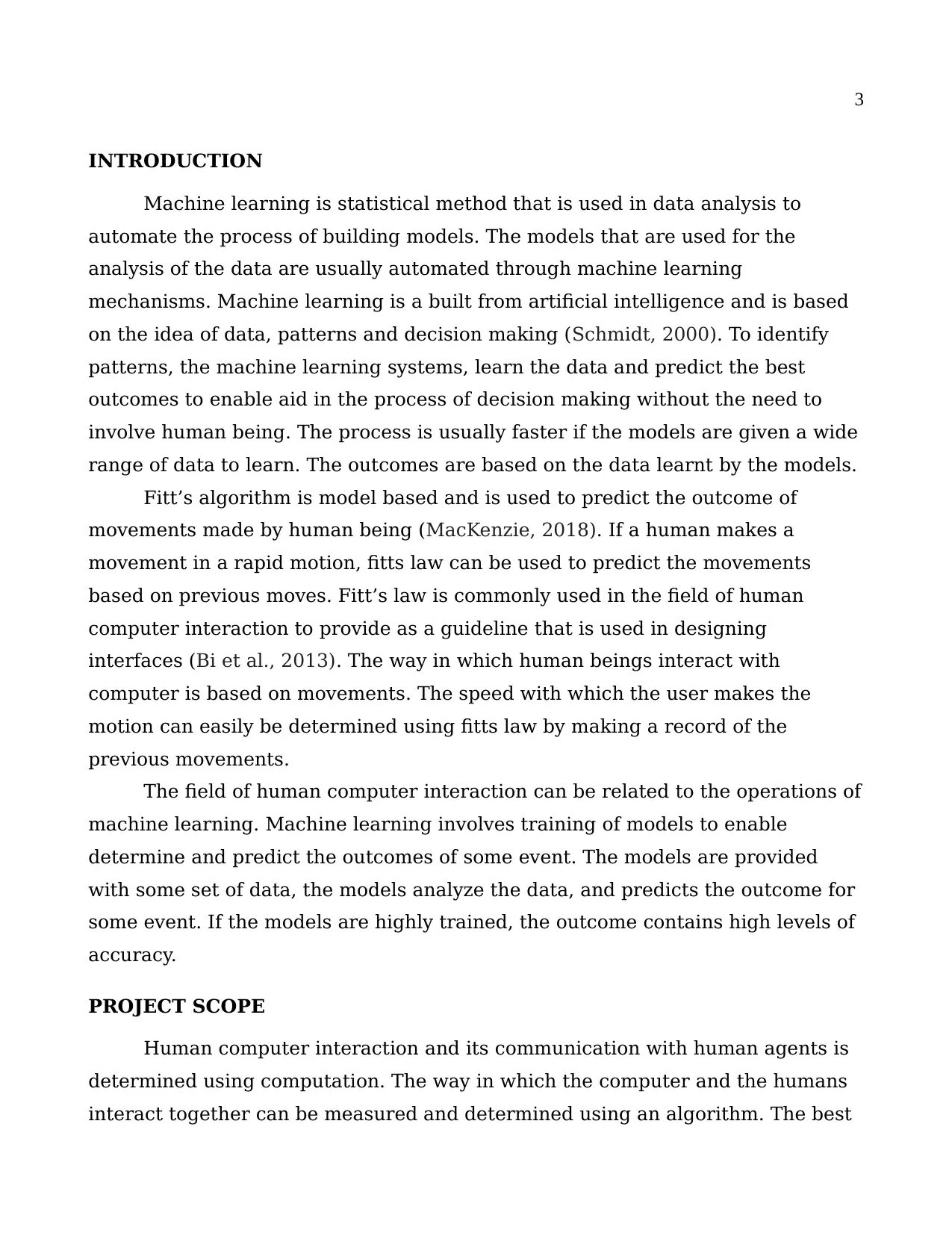
3
INTRODUCTION
Machine learning is statistical method that is used in data analysis to
automate the process of building models. The models that are used for the
analysis of the data are usually automated through machine learning
mechanisms. Machine learning is a built from artificial intelligence and is based
on the idea of data, patterns and decision making (Schmidt, 2000). To identify
patterns, the machine learning systems, learn the data and predict the best
outcomes to enable aid in the process of decision making without the need to
involve human being. The process is usually faster if the models are given a wide
range of data to learn. The outcomes are based on the data learnt by the models.
Fitt’s algorithm is model based and is used to predict the outcome of
movements made by human being (MacKenzie, 2018). If a human makes a
movement in a rapid motion, fitts law can be used to predict the movements
based on previous moves. Fitt’s law is commonly used in the field of human
computer interaction to provide as a guideline that is used in designing
interfaces (Bi et al., 2013). The way in which human beings interact with
computer is based on movements. The speed with which the user makes the
motion can easily be determined using fitts law by making a record of the
previous movements.
The field of human computer interaction can be related to the operations of
machine learning. Machine learning involves training of models to enable
determine and predict the outcomes of some event. The models are provided
with some set of data, the models analyze the data, and predicts the outcome for
some event. If the models are highly trained, the outcome contains high levels of
accuracy.
PROJECT SCOPE
Human computer interaction and its communication with human agents is
determined using computation. The way in which the computer and the humans
interact together can be measured and determined using an algorithm. The best
INTRODUCTION
Machine learning is statistical method that is used in data analysis to
automate the process of building models. The models that are used for the
analysis of the data are usually automated through machine learning
mechanisms. Machine learning is a built from artificial intelligence and is based
on the idea of data, patterns and decision making (Schmidt, 2000). To identify
patterns, the machine learning systems, learn the data and predict the best
outcomes to enable aid in the process of decision making without the need to
involve human being. The process is usually faster if the models are given a wide
range of data to learn. The outcomes are based on the data learnt by the models.
Fitt’s algorithm is model based and is used to predict the outcome of
movements made by human being (MacKenzie, 2018). If a human makes a
movement in a rapid motion, fitts law can be used to predict the movements
based on previous moves. Fitt’s law is commonly used in the field of human
computer interaction to provide as a guideline that is used in designing
interfaces (Bi et al., 2013). The way in which human beings interact with
computer is based on movements. The speed with which the user makes the
motion can easily be determined using fitts law by making a record of the
previous movements.
The field of human computer interaction can be related to the operations of
machine learning. Machine learning involves training of models to enable
determine and predict the outcomes of some event. The models are provided
with some set of data, the models analyze the data, and predicts the outcome for
some event. If the models are highly trained, the outcome contains high levels of
accuracy.
PROJECT SCOPE
Human computer interaction and its communication with human agents is
determined using computation. The way in which the computer and the humans
interact together can be measured and determined using an algorithm. The best
Paraphrase This Document
Need a fresh take? Get an instant paraphrase of this document with our AI Paraphraser
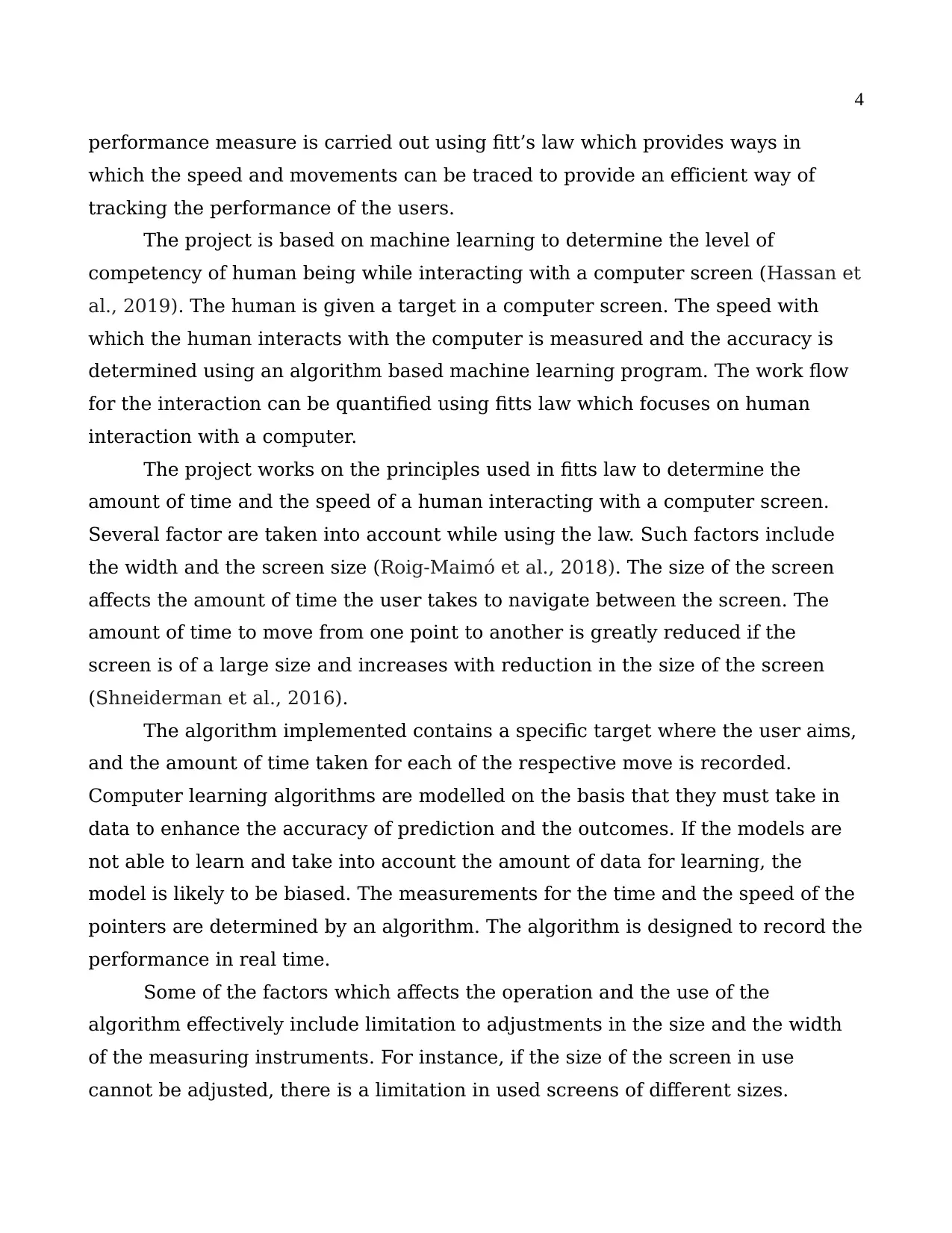
4
performance measure is carried out using fitt’s law which provides ways in
which the speed and movements can be traced to provide an efficient way of
tracking the performance of the users.
The project is based on machine learning to determine the level of
competency of human being while interacting with a computer screen (Hassan et
al., 2019). The human is given a target in a computer screen. The speed with
which the human interacts with the computer is measured and the accuracy is
determined using an algorithm based machine learning program. The work flow
for the interaction can be quantified using fitts law which focuses on human
interaction with a computer.
The project works on the principles used in fitts law to determine the
amount of time and the speed of a human interacting with a computer screen.
Several factor are taken into account while using the law. Such factors include
the width and the screen size (Roig-Maimó et al., 2018). The size of the screen
affects the amount of time the user takes to navigate between the screen. The
amount of time to move from one point to another is greatly reduced if the
screen is of a large size and increases with reduction in the size of the screen
(Shneiderman et al., 2016).
The algorithm implemented contains a specific target where the user aims,
and the amount of time taken for each of the respective move is recorded.
Computer learning algorithms are modelled on the basis that they must take in
data to enhance the accuracy of prediction and the outcomes. If the models are
not able to learn and take into account the amount of data for learning, the
model is likely to be biased. The measurements for the time and the speed of the
pointers are determined by an algorithm. The algorithm is designed to record the
performance in real time.
Some of the factors which affects the operation and the use of the
algorithm effectively include limitation to adjustments in the size and the width
of the measuring instruments. For instance, if the size of the screen in use
cannot be adjusted, there is a limitation in used screens of different sizes.
performance measure is carried out using fitt’s law which provides ways in
which the speed and movements can be traced to provide an efficient way of
tracking the performance of the users.
The project is based on machine learning to determine the level of
competency of human being while interacting with a computer screen (Hassan et
al., 2019). The human is given a target in a computer screen. The speed with
which the human interacts with the computer is measured and the accuracy is
determined using an algorithm based machine learning program. The work flow
for the interaction can be quantified using fitts law which focuses on human
interaction with a computer.
The project works on the principles used in fitts law to determine the
amount of time and the speed of a human interacting with a computer screen.
Several factor are taken into account while using the law. Such factors include
the width and the screen size (Roig-Maimó et al., 2018). The size of the screen
affects the amount of time the user takes to navigate between the screen. The
amount of time to move from one point to another is greatly reduced if the
screen is of a large size and increases with reduction in the size of the screen
(Shneiderman et al., 2016).
The algorithm implemented contains a specific target where the user aims,
and the amount of time taken for each of the respective move is recorded.
Computer learning algorithms are modelled on the basis that they must take in
data to enhance the accuracy of prediction and the outcomes. If the models are
not able to learn and take into account the amount of data for learning, the
model is likely to be biased. The measurements for the time and the speed of the
pointers are determined by an algorithm. The algorithm is designed to record the
performance in real time.
Some of the factors which affects the operation and the use of the
algorithm effectively include limitation to adjustments in the size and the width
of the measuring instruments. For instance, if the size of the screen in use
cannot be adjusted, there is a limitation in used screens of different sizes.
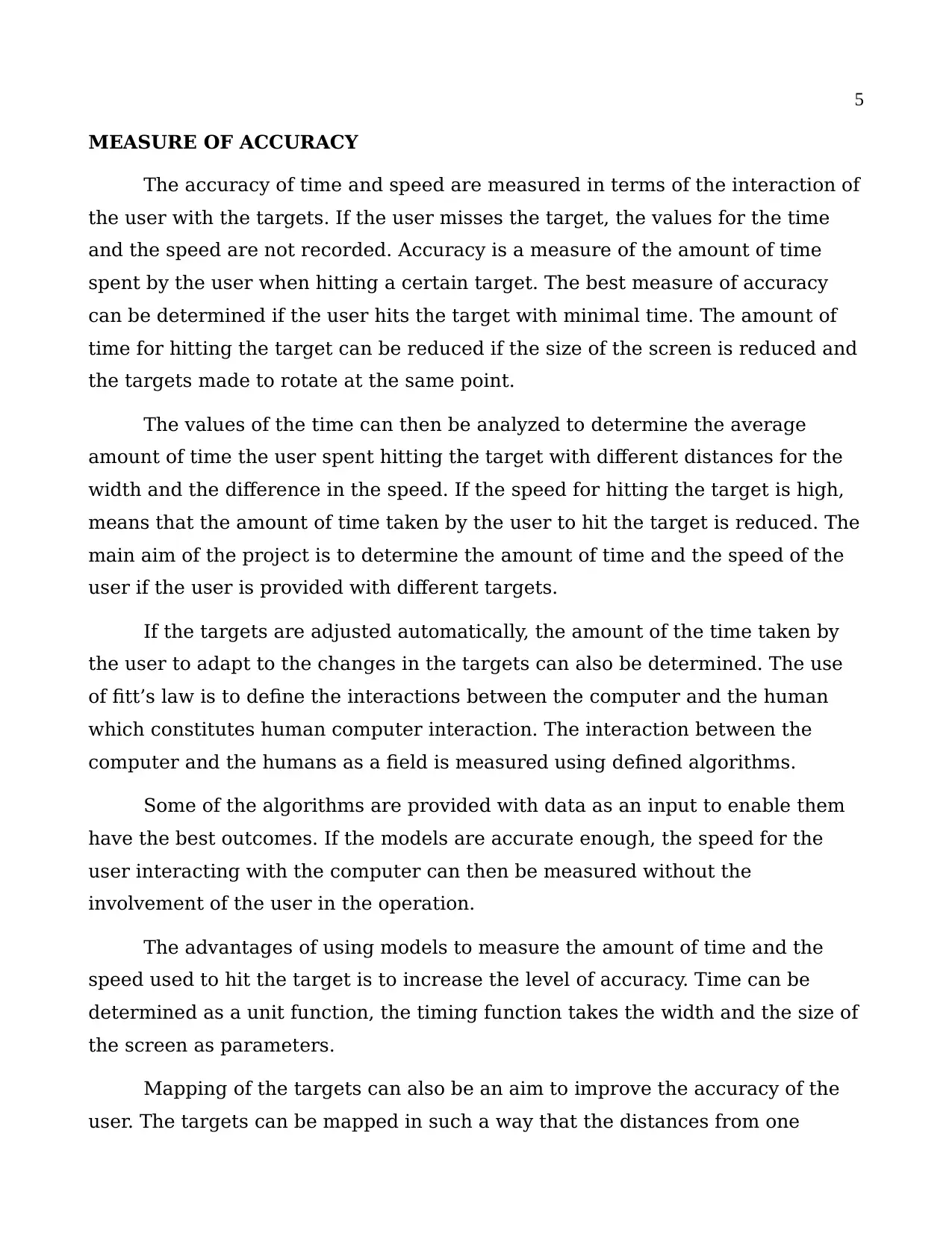
5
MEASURE OF ACCURACY
The accuracy of time and speed are measured in terms of the interaction of
the user with the targets. If the user misses the target, the values for the time
and the speed are not recorded. Accuracy is a measure of the amount of time
spent by the user when hitting a certain target. The best measure of accuracy
can be determined if the user hits the target with minimal time. The amount of
time for hitting the target can be reduced if the size of the screen is reduced and
the targets made to rotate at the same point.
The values of the time can then be analyzed to determine the average
amount of time the user spent hitting the target with different distances for the
width and the difference in the speed. If the speed for hitting the target is high,
means that the amount of time taken by the user to hit the target is reduced. The
main aim of the project is to determine the amount of time and the speed of the
user if the user is provided with different targets.
If the targets are adjusted automatically, the amount of the time taken by
the user to adapt to the changes in the targets can also be determined. The use
of fitt’s law is to define the interactions between the computer and the human
which constitutes human computer interaction. The interaction between the
computer and the humans as a field is measured using defined algorithms.
Some of the algorithms are provided with data as an input to enable them
have the best outcomes. If the models are accurate enough, the speed for the
user interacting with the computer can then be measured without the
involvement of the user in the operation.
The advantages of using models to measure the amount of time and the
speed used to hit the target is to increase the level of accuracy. Time can be
determined as a unit function, the timing function takes the width and the size of
the screen as parameters.
Mapping of the targets can also be an aim to improve the accuracy of the
user. The targets can be mapped in such a way that the distances from one
MEASURE OF ACCURACY
The accuracy of time and speed are measured in terms of the interaction of
the user with the targets. If the user misses the target, the values for the time
and the speed are not recorded. Accuracy is a measure of the amount of time
spent by the user when hitting a certain target. The best measure of accuracy
can be determined if the user hits the target with minimal time. The amount of
time for hitting the target can be reduced if the size of the screen is reduced and
the targets made to rotate at the same point.
The values of the time can then be analyzed to determine the average
amount of time the user spent hitting the target with different distances for the
width and the difference in the speed. If the speed for hitting the target is high,
means that the amount of time taken by the user to hit the target is reduced. The
main aim of the project is to determine the amount of time and the speed of the
user if the user is provided with different targets.
If the targets are adjusted automatically, the amount of the time taken by
the user to adapt to the changes in the targets can also be determined. The use
of fitt’s law is to define the interactions between the computer and the human
which constitutes human computer interaction. The interaction between the
computer and the humans as a field is measured using defined algorithms.
Some of the algorithms are provided with data as an input to enable them
have the best outcomes. If the models are accurate enough, the speed for the
user interacting with the computer can then be measured without the
involvement of the user in the operation.
The advantages of using models to measure the amount of time and the
speed used to hit the target is to increase the level of accuracy. Time can be
determined as a unit function, the timing function takes the width and the size of
the screen as parameters.
Mapping of the targets can also be an aim to improve the accuracy of the
user. The targets can be mapped in such a way that the distances from one
⊘ This is a preview!⊘
Do you want full access?
Subscribe today to unlock all pages.

Trusted by 1+ million students worldwide
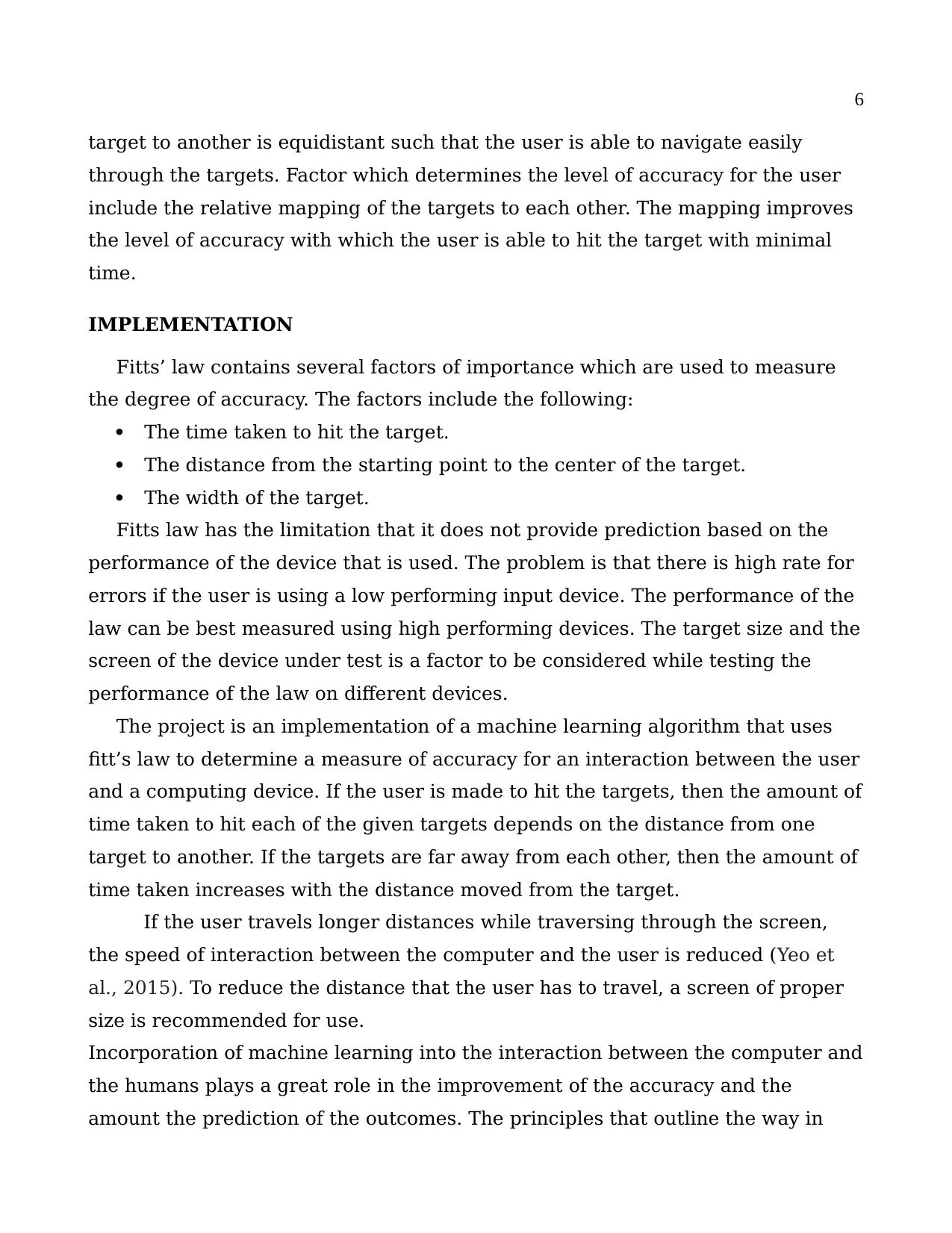
6
target to another is equidistant such that the user is able to navigate easily
through the targets. Factor which determines the level of accuracy for the user
include the relative mapping of the targets to each other. The mapping improves
the level of accuracy with which the user is able to hit the target with minimal
time.
IMPLEMENTATION
Fitts’ law contains several factors of importance which are used to measure
the degree of accuracy. The factors include the following:
The time taken to hit the target.
The distance from the starting point to the center of the target.
The width of the target.
Fitts law has the limitation that it does not provide prediction based on the
performance of the device that is used. The problem is that there is high rate for
errors if the user is using a low performing input device. The performance of the
law can be best measured using high performing devices. The target size and the
screen of the device under test is a factor to be considered while testing the
performance of the law on different devices.
The project is an implementation of a machine learning algorithm that uses
fitt’s law to determine a measure of accuracy for an interaction between the user
and a computing device. If the user is made to hit the targets, then the amount of
time taken to hit each of the given targets depends on the distance from one
target to another. If the targets are far away from each other, then the amount of
time taken increases with the distance moved from the target.
If the user travels longer distances while traversing through the screen,
the speed of interaction between the computer and the user is reduced (Yeo et
al., 2015). To reduce the distance that the user has to travel, a screen of proper
size is recommended for use.
Incorporation of machine learning into the interaction between the computer and
the humans plays a great role in the improvement of the accuracy and the
amount the prediction of the outcomes. The principles that outline the way in
target to another is equidistant such that the user is able to navigate easily
through the targets. Factor which determines the level of accuracy for the user
include the relative mapping of the targets to each other. The mapping improves
the level of accuracy with which the user is able to hit the target with minimal
time.
IMPLEMENTATION
Fitts’ law contains several factors of importance which are used to measure
the degree of accuracy. The factors include the following:
The time taken to hit the target.
The distance from the starting point to the center of the target.
The width of the target.
Fitts law has the limitation that it does not provide prediction based on the
performance of the device that is used. The problem is that there is high rate for
errors if the user is using a low performing input device. The performance of the
law can be best measured using high performing devices. The target size and the
screen of the device under test is a factor to be considered while testing the
performance of the law on different devices.
The project is an implementation of a machine learning algorithm that uses
fitt’s law to determine a measure of accuracy for an interaction between the user
and a computing device. If the user is made to hit the targets, then the amount of
time taken to hit each of the given targets depends on the distance from one
target to another. If the targets are far away from each other, then the amount of
time taken increases with the distance moved from the target.
If the user travels longer distances while traversing through the screen,
the speed of interaction between the computer and the user is reduced (Yeo et
al., 2015). To reduce the distance that the user has to travel, a screen of proper
size is recommended for use.
Incorporation of machine learning into the interaction between the computer and
the humans plays a great role in the improvement of the accuracy and the
amount the prediction of the outcomes. The principles that outline the way in
Paraphrase This Document
Need a fresh take? Get an instant paraphrase of this document with our AI Paraphraser
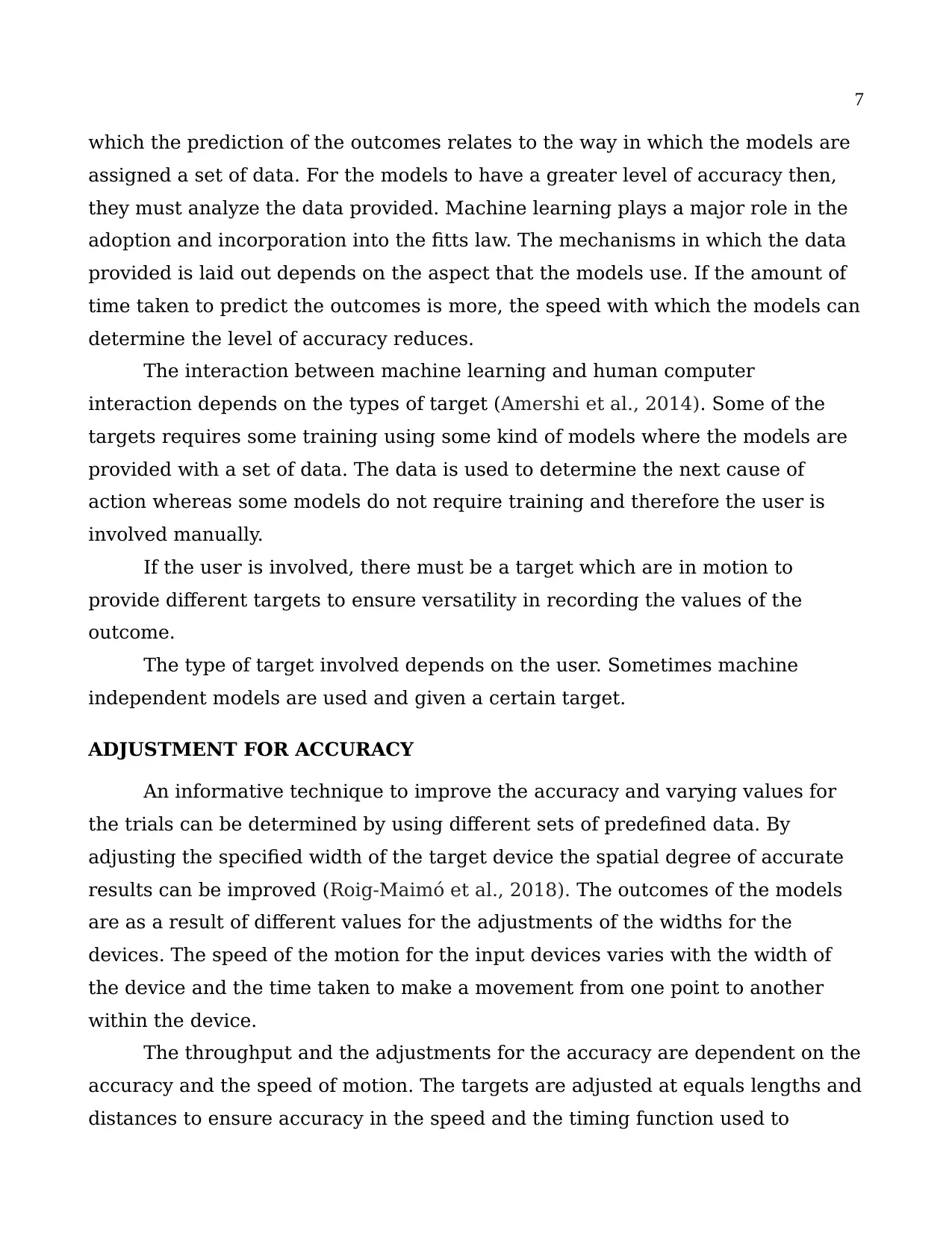
7
which the prediction of the outcomes relates to the way in which the models are
assigned a set of data. For the models to have a greater level of accuracy then,
they must analyze the data provided. Machine learning plays a major role in the
adoption and incorporation into the fitts law. The mechanisms in which the data
provided is laid out depends on the aspect that the models use. If the amount of
time taken to predict the outcomes is more, the speed with which the models can
determine the level of accuracy reduces.
The interaction between machine learning and human computer
interaction depends on the types of target (Amershi et al., 2014). Some of the
targets requires some training using some kind of models where the models are
provided with a set of data. The data is used to determine the next cause of
action whereas some models do not require training and therefore the user is
involved manually.
If the user is involved, there must be a target which are in motion to
provide different targets to ensure versatility in recording the values of the
outcome.
The type of target involved depends on the user. Sometimes machine
independent models are used and given a certain target.
ADJUSTMENT FOR ACCURACY
An informative technique to improve the accuracy and varying values for
the trials can be determined by using different sets of predefined data. By
adjusting the specified width of the target device the spatial degree of accurate
results can be improved (Roig-Maimó et al., 2018). The outcomes of the models
are as a result of different values for the adjustments of the widths for the
devices. The speed of the motion for the input devices varies with the width of
the device and the time taken to make a movement from one point to another
within the device.
The throughput and the adjustments for the accuracy are dependent on the
accuracy and the speed of motion. The targets are adjusted at equals lengths and
distances to ensure accuracy in the speed and the timing function used to
which the prediction of the outcomes relates to the way in which the models are
assigned a set of data. For the models to have a greater level of accuracy then,
they must analyze the data provided. Machine learning plays a major role in the
adoption and incorporation into the fitts law. The mechanisms in which the data
provided is laid out depends on the aspect that the models use. If the amount of
time taken to predict the outcomes is more, the speed with which the models can
determine the level of accuracy reduces.
The interaction between machine learning and human computer
interaction depends on the types of target (Amershi et al., 2014). Some of the
targets requires some training using some kind of models where the models are
provided with a set of data. The data is used to determine the next cause of
action whereas some models do not require training and therefore the user is
involved manually.
If the user is involved, there must be a target which are in motion to
provide different targets to ensure versatility in recording the values of the
outcome.
The type of target involved depends on the user. Sometimes machine
independent models are used and given a certain target.
ADJUSTMENT FOR ACCURACY
An informative technique to improve the accuracy and varying values for
the trials can be determined by using different sets of predefined data. By
adjusting the specified width of the target device the spatial degree of accurate
results can be improved (Roig-Maimó et al., 2018). The outcomes of the models
are as a result of different values for the adjustments of the widths for the
devices. The speed of the motion for the input devices varies with the width of
the device and the time taken to make a movement from one point to another
within the device.
The throughput and the adjustments for the accuracy are dependent on the
accuracy and the speed of motion. The targets are adjusted at equals lengths and
distances to ensure accuracy in the speed and the timing function used to
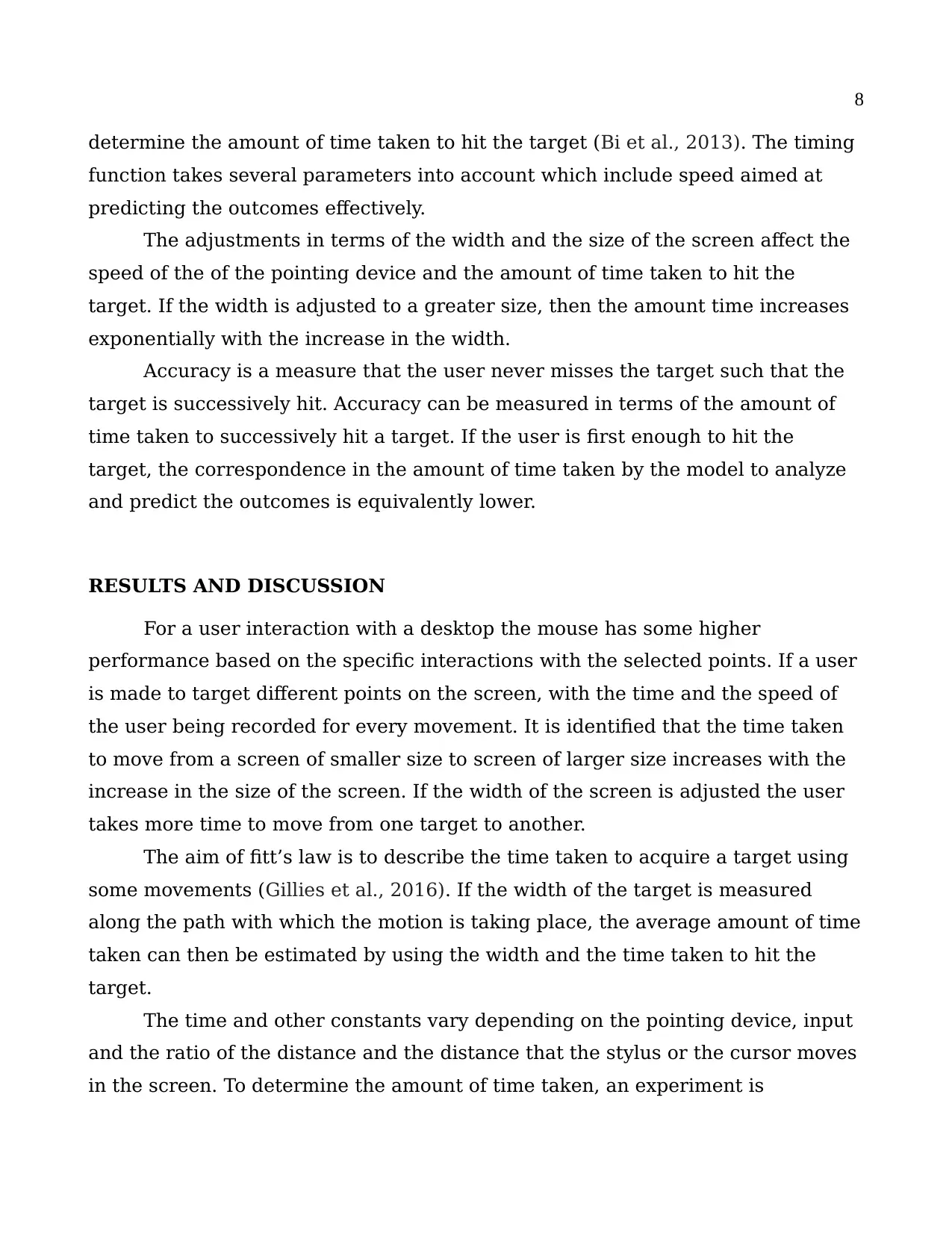
8
determine the amount of time taken to hit the target (Bi et al., 2013). The timing
function takes several parameters into account which include speed aimed at
predicting the outcomes effectively.
The adjustments in terms of the width and the size of the screen affect the
speed of the of the pointing device and the amount of time taken to hit the
target. If the width is adjusted to a greater size, then the amount time increases
exponentially with the increase in the width.
Accuracy is a measure that the user never misses the target such that the
target is successively hit. Accuracy can be measured in terms of the amount of
time taken to successively hit a target. If the user is first enough to hit the
target, the correspondence in the amount of time taken by the model to analyze
and predict the outcomes is equivalently lower.
RESULTS AND DISCUSSION
For a user interaction with a desktop the mouse has some higher
performance based on the specific interactions with the selected points. If a user
is made to target different points on the screen, with the time and the speed of
the user being recorded for every movement. It is identified that the time taken
to move from a screen of smaller size to screen of larger size increases with the
increase in the size of the screen. If the width of the screen is adjusted the user
takes more time to move from one target to another.
The aim of fitt’s law is to describe the time taken to acquire a target using
some movements (Gillies et al., 2016). If the width of the target is measured
along the path with which the motion is taking place, the average amount of time
taken can then be estimated by using the width and the time taken to hit the
target.
The time and other constants vary depending on the pointing device, input
and the ratio of the distance and the distance that the stylus or the cursor moves
in the screen. To determine the amount of time taken, an experiment is
determine the amount of time taken to hit the target (Bi et al., 2013). The timing
function takes several parameters into account which include speed aimed at
predicting the outcomes effectively.
The adjustments in terms of the width and the size of the screen affect the
speed of the of the pointing device and the amount of time taken to hit the
target. If the width is adjusted to a greater size, then the amount time increases
exponentially with the increase in the width.
Accuracy is a measure that the user never misses the target such that the
target is successively hit. Accuracy can be measured in terms of the amount of
time taken to successively hit a target. If the user is first enough to hit the
target, the correspondence in the amount of time taken by the model to analyze
and predict the outcomes is equivalently lower.
RESULTS AND DISCUSSION
For a user interaction with a desktop the mouse has some higher
performance based on the specific interactions with the selected points. If a user
is made to target different points on the screen, with the time and the speed of
the user being recorded for every movement. It is identified that the time taken
to move from a screen of smaller size to screen of larger size increases with the
increase in the size of the screen. If the width of the screen is adjusted the user
takes more time to move from one target to another.
The aim of fitt’s law is to describe the time taken to acquire a target using
some movements (Gillies et al., 2016). If the width of the target is measured
along the path with which the motion is taking place, the average amount of time
taken can then be estimated by using the width and the time taken to hit the
target.
The time and other constants vary depending on the pointing device, input
and the ratio of the distance and the distance that the stylus or the cursor moves
in the screen. To determine the amount of time taken, an experiment is
⊘ This is a preview!⊘
Do you want full access?
Subscribe today to unlock all pages.

Trusted by 1+ million students worldwide
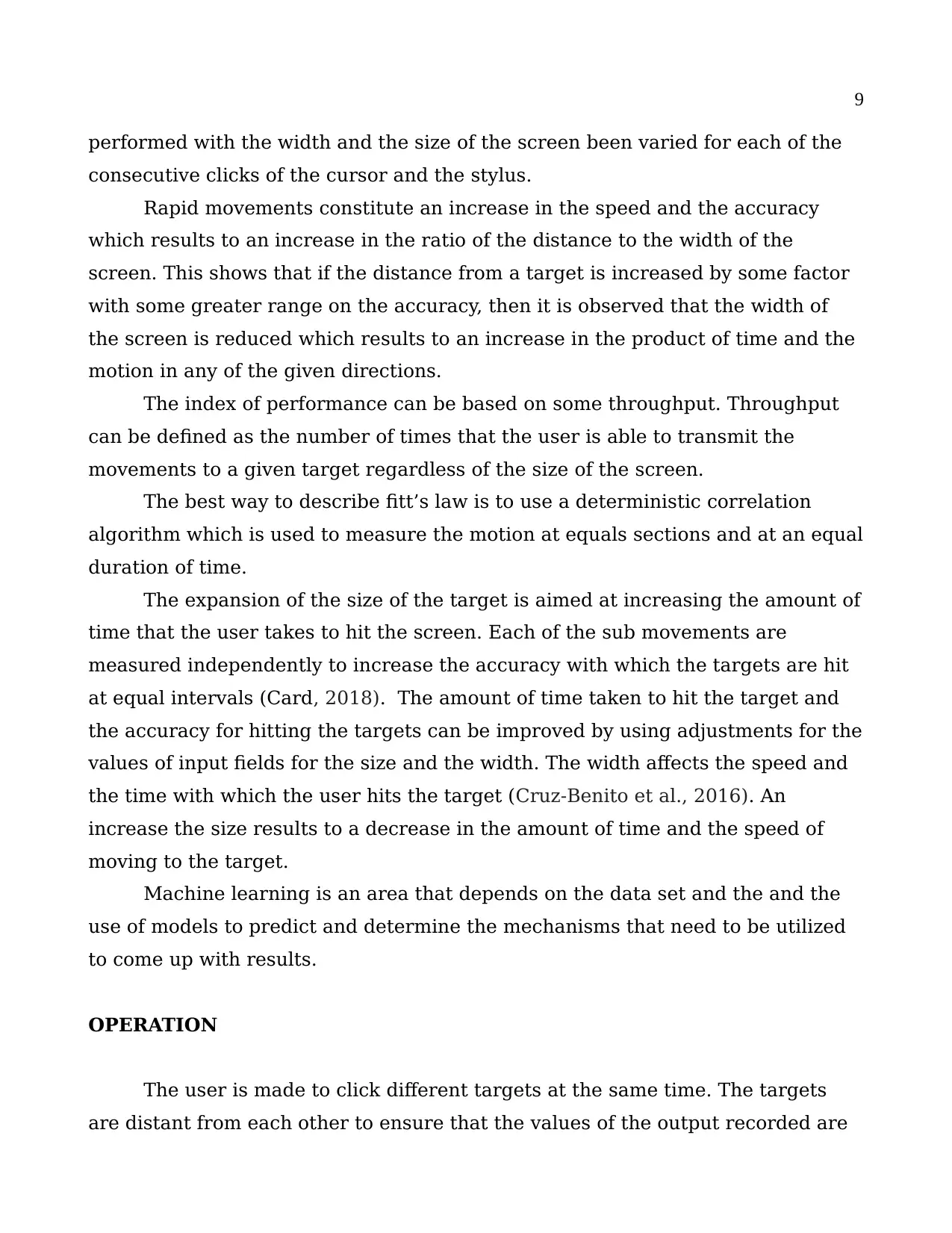
9
performed with the width and the size of the screen been varied for each of the
consecutive clicks of the cursor and the stylus.
Rapid movements constitute an increase in the speed and the accuracy
which results to an increase in the ratio of the distance to the width of the
screen. This shows that if the distance from a target is increased by some factor
with some greater range on the accuracy, then it is observed that the width of
the screen is reduced which results to an increase in the product of time and the
motion in any of the given directions.
The index of performance can be based on some throughput. Throughput
can be defined as the number of times that the user is able to transmit the
movements to a given target regardless of the size of the screen.
The best way to describe fitt’s law is to use a deterministic correlation
algorithm which is used to measure the motion at equals sections and at an equal
duration of time.
The expansion of the size of the target is aimed at increasing the amount of
time that the user takes to hit the screen. Each of the sub movements are
measured independently to increase the accuracy with which the targets are hit
at equal intervals (Card, 2018). The amount of time taken to hit the target and
the accuracy for hitting the targets can be improved by using adjustments for the
values of input fields for the size and the width. The width affects the speed and
the time with which the user hits the target (Cruz-Benito et al., 2016). An
increase the size results to a decrease in the amount of time and the speed of
moving to the target.
Machine learning is an area that depends on the data set and the and the
use of models to predict and determine the mechanisms that need to be utilized
to come up with results.
OPERATION
The user is made to click different targets at the same time. The targets
are distant from each other to ensure that the values of the output recorded are
performed with the width and the size of the screen been varied for each of the
consecutive clicks of the cursor and the stylus.
Rapid movements constitute an increase in the speed and the accuracy
which results to an increase in the ratio of the distance to the width of the
screen. This shows that if the distance from a target is increased by some factor
with some greater range on the accuracy, then it is observed that the width of
the screen is reduced which results to an increase in the product of time and the
motion in any of the given directions.
The index of performance can be based on some throughput. Throughput
can be defined as the number of times that the user is able to transmit the
movements to a given target regardless of the size of the screen.
The best way to describe fitt’s law is to use a deterministic correlation
algorithm which is used to measure the motion at equals sections and at an equal
duration of time.
The expansion of the size of the target is aimed at increasing the amount of
time that the user takes to hit the screen. Each of the sub movements are
measured independently to increase the accuracy with which the targets are hit
at equal intervals (Card, 2018). The amount of time taken to hit the target and
the accuracy for hitting the targets can be improved by using adjustments for the
values of input fields for the size and the width. The width affects the speed and
the time with which the user hits the target (Cruz-Benito et al., 2016). An
increase the size results to a decrease in the amount of time and the speed of
moving to the target.
Machine learning is an area that depends on the data set and the and the
use of models to predict and determine the mechanisms that need to be utilized
to come up with results.
OPERATION
The user is made to click different targets at the same time. The targets
are distant from each other to ensure that the values of the output recorded are
Paraphrase This Document
Need a fresh take? Get an instant paraphrase of this document with our AI Paraphraser
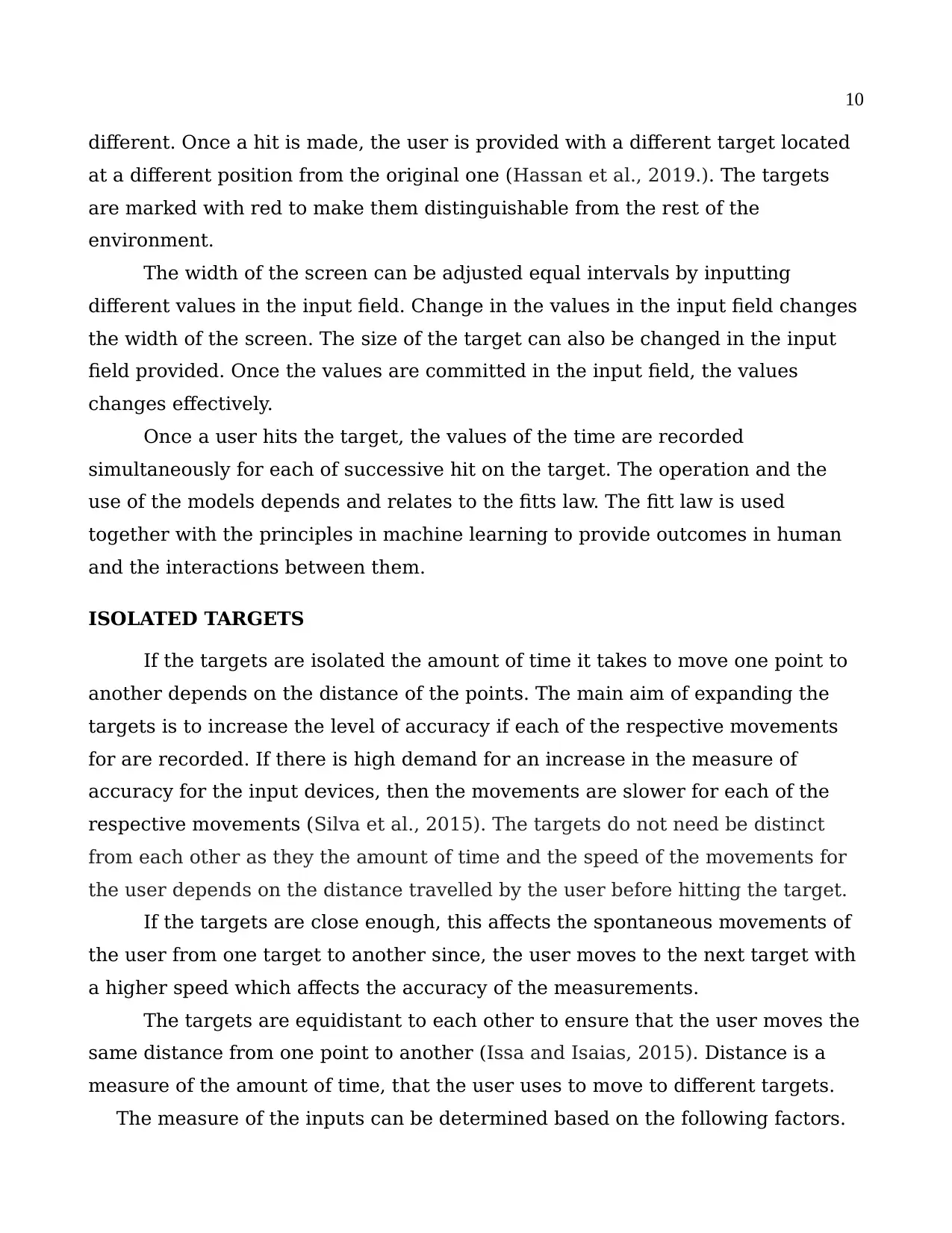
10
different. Once a hit is made, the user is provided with a different target located
at a different position from the original one (Hassan et al., 2019.). The targets
are marked with red to make them distinguishable from the rest of the
environment.
The width of the screen can be adjusted equal intervals by inputting
different values in the input field. Change in the values in the input field changes
the width of the screen. The size of the target can also be changed in the input
field provided. Once the values are committed in the input field, the values
changes effectively.
Once a user hits the target, the values of the time are recorded
simultaneously for each of successive hit on the target. The operation and the
use of the models depends and relates to the fitts law. The fitt law is used
together with the principles in machine learning to provide outcomes in human
and the interactions between them.
ISOLATED TARGETS
If the targets are isolated the amount of time it takes to move one point to
another depends on the distance of the points. The main aim of expanding the
targets is to increase the level of accuracy if each of the respective movements
for are recorded. If there is high demand for an increase in the measure of
accuracy for the input devices, then the movements are slower for each of the
respective movements (Silva et al., 2015). The targets do not need be distinct
from each other as they the amount of time and the speed of the movements for
the user depends on the distance travelled by the user before hitting the target.
If the targets are close enough, this affects the spontaneous movements of
the user from one target to another since, the user moves to the next target with
a higher speed which affects the accuracy of the measurements.
The targets are equidistant to each other to ensure that the user moves the
same distance from one point to another (Issa and Isaias, 2015). Distance is a
measure of the amount of time, that the user uses to move to different targets.
The measure of the inputs can be determined based on the following factors.
different. Once a hit is made, the user is provided with a different target located
at a different position from the original one (Hassan et al., 2019.). The targets
are marked with red to make them distinguishable from the rest of the
environment.
The width of the screen can be adjusted equal intervals by inputting
different values in the input field. Change in the values in the input field changes
the width of the screen. The size of the target can also be changed in the input
field provided. Once the values are committed in the input field, the values
changes effectively.
Once a user hits the target, the values of the time are recorded
simultaneously for each of successive hit on the target. The operation and the
use of the models depends and relates to the fitts law. The fitt law is used
together with the principles in machine learning to provide outcomes in human
and the interactions between them.
ISOLATED TARGETS
If the targets are isolated the amount of time it takes to move one point to
another depends on the distance of the points. The main aim of expanding the
targets is to increase the level of accuracy if each of the respective movements
for are recorded. If there is high demand for an increase in the measure of
accuracy for the input devices, then the movements are slower for each of the
respective movements (Silva et al., 2015). The targets do not need be distinct
from each other as they the amount of time and the speed of the movements for
the user depends on the distance travelled by the user before hitting the target.
If the targets are close enough, this affects the spontaneous movements of
the user from one target to another since, the user moves to the next target with
a higher speed which affects the accuracy of the measurements.
The targets are equidistant to each other to ensure that the user moves the
same distance from one point to another (Issa and Isaias, 2015). Distance is a
measure of the amount of time, that the user uses to move to different targets.
The measure of the inputs can be determined based on the following factors.
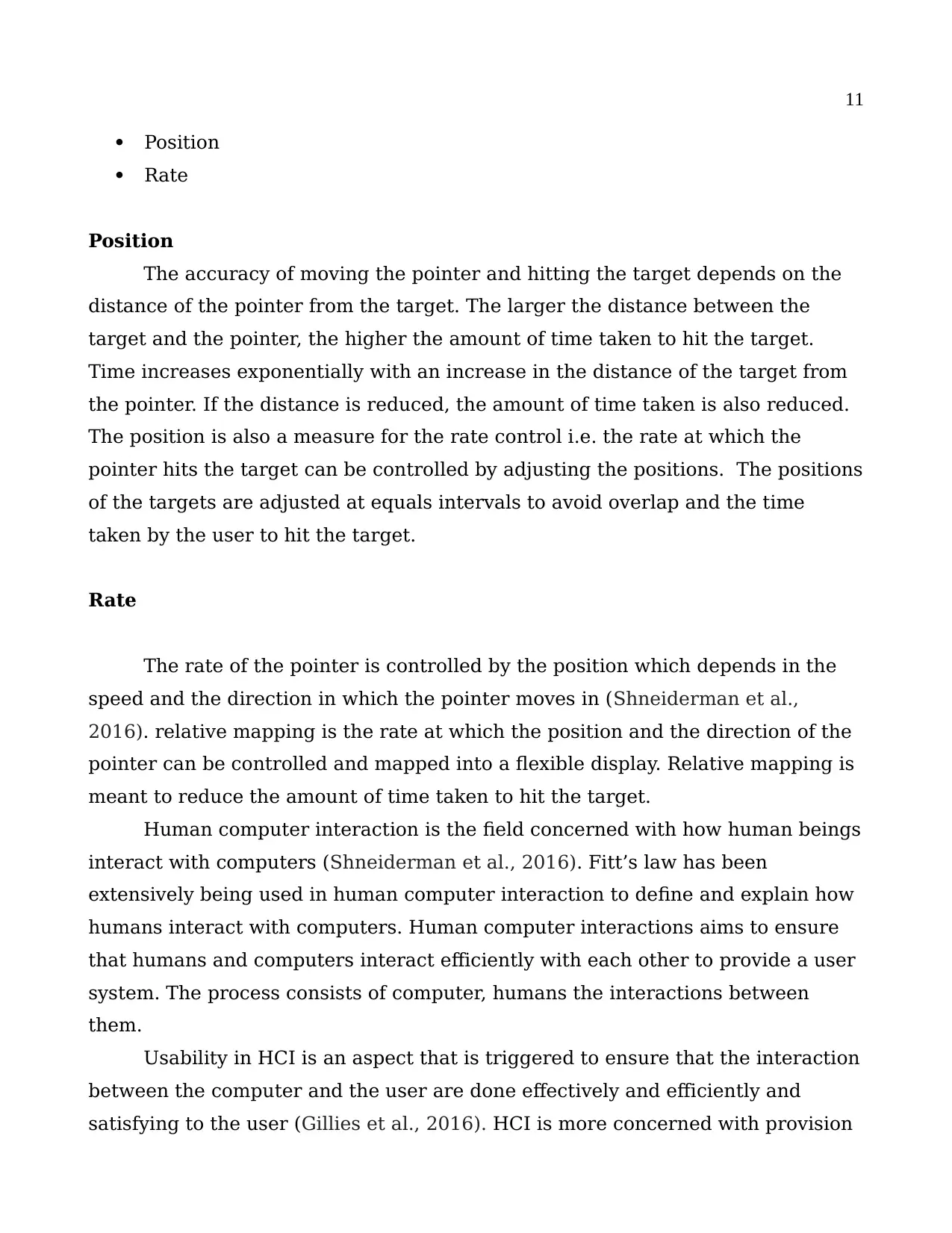
11
Position
Rate
Position
The accuracy of moving the pointer and hitting the target depends on the
distance of the pointer from the target. The larger the distance between the
target and the pointer, the higher the amount of time taken to hit the target.
Time increases exponentially with an increase in the distance of the target from
the pointer. If the distance is reduced, the amount of time taken is also reduced.
The position is also a measure for the rate control i.e. the rate at which the
pointer hits the target can be controlled by adjusting the positions. The positions
of the targets are adjusted at equals intervals to avoid overlap and the time
taken by the user to hit the target.
Rate
The rate of the pointer is controlled by the position which depends in the
speed and the direction in which the pointer moves in (Shneiderman et al.,
2016). relative mapping is the rate at which the position and the direction of the
pointer can be controlled and mapped into a flexible display. Relative mapping is
meant to reduce the amount of time taken to hit the target.
Human computer interaction is the field concerned with how human beings
interact with computers (Shneiderman et al., 2016). Fitt’s law has been
extensively being used in human computer interaction to define and explain how
humans interact with computers. Human computer interactions aims to ensure
that humans and computers interact efficiently with each other to provide a user
system. The process consists of computer, humans the interactions between
them.
Usability in HCI is an aspect that is triggered to ensure that the interaction
between the computer and the user are done effectively and efficiently and
satisfying to the user (Gillies et al., 2016). HCI is more concerned with provision
Position
Rate
Position
The accuracy of moving the pointer and hitting the target depends on the
distance of the pointer from the target. The larger the distance between the
target and the pointer, the higher the amount of time taken to hit the target.
Time increases exponentially with an increase in the distance of the target from
the pointer. If the distance is reduced, the amount of time taken is also reduced.
The position is also a measure for the rate control i.e. the rate at which the
pointer hits the target can be controlled by adjusting the positions. The positions
of the targets are adjusted at equals intervals to avoid overlap and the time
taken by the user to hit the target.
Rate
The rate of the pointer is controlled by the position which depends in the
speed and the direction in which the pointer moves in (Shneiderman et al.,
2016). relative mapping is the rate at which the position and the direction of the
pointer can be controlled and mapped into a flexible display. Relative mapping is
meant to reduce the amount of time taken to hit the target.
Human computer interaction is the field concerned with how human beings
interact with computers (Shneiderman et al., 2016). Fitt’s law has been
extensively being used in human computer interaction to define and explain how
humans interact with computers. Human computer interactions aims to ensure
that humans and computers interact efficiently with each other to provide a user
system. The process consists of computer, humans the interactions between
them.
Usability in HCI is an aspect that is triggered to ensure that the interaction
between the computer and the user are done effectively and efficiently and
satisfying to the user (Gillies et al., 2016). HCI is more concerned with provision
⊘ This is a preview!⊘
Do you want full access?
Subscribe today to unlock all pages.

Trusted by 1+ million students worldwide
1 out of 15
Related Documents
Your All-in-One AI-Powered Toolkit for Academic Success.
+13062052269
info@desklib.com
Available 24*7 on WhatsApp / Email
![[object Object]](/_next/static/media/star-bottom.7253800d.svg)
Unlock your academic potential
Copyright © 2020–2025 A2Z Services. All Rights Reserved. Developed and managed by ZUCOL.





